After many days of rice noodles and pho recipe write, I decided to bake bread for homemade banh mi. It was early, around 8am, when I started, and for some reason, I decided to go rogue and tinker with my tried-and-true banh mi roll recipe, the one that I'd worked on for three months for The Banh Mi Handbook.
The tinkering had to do with using an industrial leavening: dough improver, or rather, mejorante para pan. It's a powdery substance that cookbook author Kate Leahy got for me by way of her aunt, who lives in Mexico and brought it to the U.S. for me. Kate's a good friend and curious cook. I'd not used the mejorante para pan in a couple of years so I was curious. Actually, I was inspired by Jyoti, a Banh Mi Handbook reader in Kenya who got her hands on dough improver and baked up some lovely rolls; she emailed me to ask how much to use and together we guesstimated an amount that worked out for her.
Anyway, I had this Mexican dough improver and after mixing up the dough, I knew something was wrong. The dough was slack but I baked it up anyway. The resulting rolls, which you see above, were hard and very very chewy - like rustic bread. I expected a puffy rise like commercially-baked bolillo roles. Not.
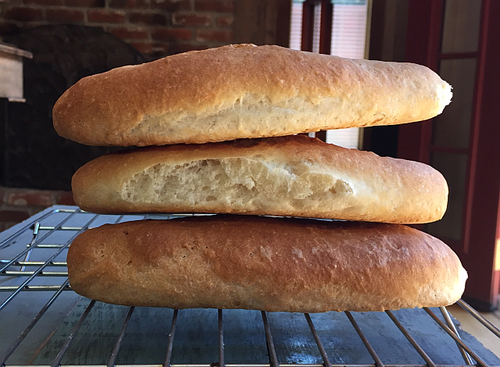
"Why are they so flat today?" Rory asked me. Because I was trying something new, I admitted. My husband indulges my experimental nature and professional obsessions. I assured him that lunch was not at stake. We were going to have banh mi. It wasn't like past times, when I was experimenting and experienced solid fails.
If you think I turn out perfect food every time, I don't. To prove it, here are highlights of my banh mi bread fiascos.
Rice Flour Vietnamese baguette - Is the secret to banh mi a crisp baguette-style roll made out of rice flour? Sorry, no. Rice flour does not rise like wheat flour because of the lack of wheat gluten. However, there's a myth that Vietnamese banh mi is made with rice flour-based baguettes. During the course of writing The Banh Mi Handbook, I spent about a week obsessed with baking rice flour baguettes from recipes published in cookbooks written by established authors. There were no finished photos for me to inspect their results but I trusted my colleagues-until I looked at the often comical results.
The above banh mi rolls (or mini-baguettes) were very hearty, i.e., texturally hard and dense. The color was not golden brown because there was a fair amount of rice flour mixed in with wheat flour. Rice flour does not brown the way wheat does. I kept lowering the amount of rice flour until I realized that it didn't do much for the bread. Turns out that rice flour may be used in small quantities to absorb humidity in the dough. Makes sense in tropical Vietnam. An America bread baker once told me that but I doubted him. Alas, I found out myself. A little rice flour yes. But a lot of rice flour yields baguettes that look like they belong in a bad museum display. Every rice flour baguette that I've baked has sadly been inedible. I threw them away.
After lots of sleuthing and a happy circumstance, I found out that dough improver/conditioner and special commercial-grade flour were the key to the crisp, light bread used for banh mi. That's how I eventually arrived at the recipe in The Banh Mi Handbook.
Gluten-Free Banh Mi Rolls - You'd think I'd learned my lesson with the rice flour. Last year I tried baking a gluten-free rolls for banh mi. I baked and off for about a month, investing a decent amount of money on various flours and starches. It was an emotional roller coaster ride as I'd watch the dough rise, then slide them into the oven to bake, only to end up with rocks.
The above were my best attempts and they were batons capable of hurting someone. I could defend myself with them but not eat them. At the supermarket, I look at gluten-free rolls with envy. I still have my notes and some day, I'm going to tackle the gluten-free rolls again.
Dough Improver Banh Mi Rolls - The latest banh mi rolls were not a total loss, as I promised my husband. I got out the accouterments and prepared tofu banh mi for us. It was a darn good sandwich. All the elements were there to create banh mi's signature synergy. The bread was simply a frame for the stuff inside, but the bread was hard to eat. After lunch, the roof of my mouth slightly ached. My husband looked at me with a look that said, "Will they stay or will they go?". The rolls went into the trash.
Thinking about what went wrong today (maybe the improver was old or I was off my bread baking game), I looked through my photo archives. I found images of the perfect banh mi rolls baked from the recipe in The Banh Mi Handbook.
Made from supermarket and health food market ingredients, the dough rises into plump torpedoes and fill the house with bread perfume as they bake. During cooling, sometimes my banh mi rolls crack ever so slightly. When that happens, I lean in to listen. I look forward to that experience again.
I've had countless mishaps on my way to success in the kitchen. Whenever there's a fail, I say to myself that it's just food and move on. I know that I'll never starve and more often than not, we eat pretty well. So keep on cooking!
What have been some of your kitchen failures and successes? I just shared mine!


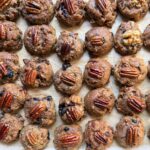



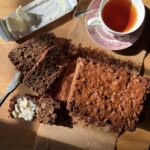
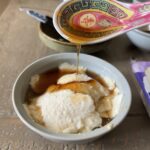
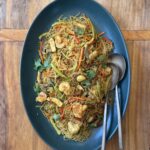
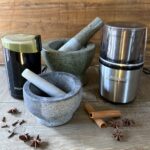




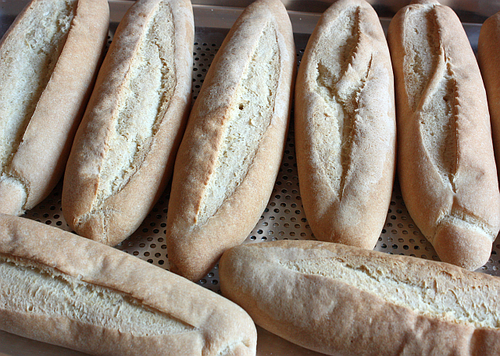



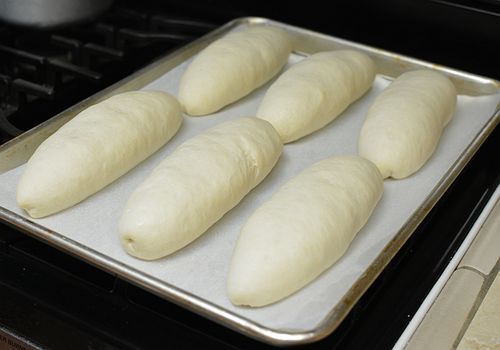


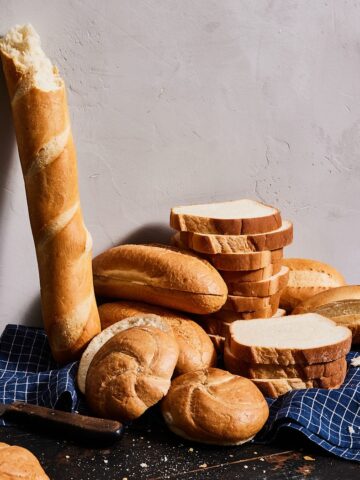


N. Tran says
You must further dissipate this absurd idea that banh mi are made with rice flour?! I also heard this from a non-vietnamese chef on Food Network....clearly didn't know what she was talking about.
The word banh mi - literally means wheat cake. yes mi - is wheat. Clearly this was introduced by the French to Vietnam. So why on earth would they ever be made by rice flour.
The most absurd thing I've ever heard.
Andrea Nguyen says
I don't know why but someone told them. I'm afraid that a little rice flour was somehow intrepreted as a lot of rice flour. Head scratcher, eh?
Vincent says
Actually when the French settled in Vietman, there was a period of time when wheat was missing so they had to use rice flour. Nowadays you can find Banh Mi with either some rice flour with wheat or just plain wheat.
Andrea Nguyen says
Was the bread that you're referring to make solely with rice flour? I've yet to see that reference. If you have it handy, please share the source. Thanks very much.
Stefan Kostoski says
Great post! Supposedly this person from our Immigration Museum in Melbourne Australia also has been taken down the garden path in relation to rice flour and banh mi. I have watched recipes in Vietnam and looked around the internet, no mention of rice flour by the professionals. You can read the article here. https://www.sbs.com.au/food/health/article/2018/03/14/banh-mi-migration-story-wrapped-fluffy-bread-roll?fbclid=IwAR36wAixg8alPw5T-uK5gL7iP60udc9CjfXmKDiHu2JDRfqvkgCiSH2Lp1E
Andrea Nguyen says
Cool. Thank you Stefan!
Bruce Hall says
Hi Andrea,
I wanted to see if I could get some help with my Banh Mi rolls. I made the recipe from your Banh Mi Handbook yesterday. I used Gold Medal Unbleached All-Purpose the flour. All ingredients were weighed using an OXO digital kitchen scale.Water temp was at 110 degrees F as measured with Thermopen. Using proofing container to track dough rise and proofing box set to 72 degrees F. Followed all the instruction carefully.
The flavor of the rolls was great but the crust was not as crackly as I hoped and the interior crumb was not as open and soft as I hoped for.
Any suggestions? I do the love the book and plan to make Lemongrass Pork sandwich soon (my wife's request)
Thank for your recipes and the great teacher that you are.
Andrea Nguyen says
Bruce, the crumb is cottony and fine. That's the nature of that dough. It's not light and soft like the bread sold at Viet markets. You could use more water or less flour but the bread may not bake up quite right. In Vietnam, there's bread of a wide range. From pricey tasty bread to very inexpensive, light rolls Most often times, there is a huge amount of dough conditioner involved in the lightweight ones (which explains their low price).
The crust is crisp on my recipe and I modeled it after good bread I've had in Vietnam and here. If you have a convection bake function, try that as it may help the bake. And maybe try Whole Foods organic AP flour. After TBMH was published, I tried that flour and it was good.
Thank you for cooking and writing!